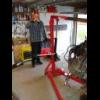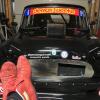No, it is not the rubbers which 'bottom out'. The tie bar threaded end has a step and the washer MUST be tightened until it is sitting hard up against this step. The fact that the rubbers will then be squashed quite a bit is the reason for the 'step'.
First of all push the tie bar through one rubber, then the 'ear' then the second rubber, then put the washer on and loosely fit the big Nyloc nut or castellated nut, or similar lock-nut).
Now fit the other end of the tie bar to the lower arm and slide the 5/16" UNF special bolt into place, put on the nut & washer, but don't tighten it yet.
Tighten the big nut at the front end of the tie-bar until the washer is seated hard against the step. Personally I never use a torque wrench, I just do it up nice & tight (and on competition cars I use a castellated nut and a split pin).
Let the car down onto its wheels so that the suspension is at normal height and finally tighten the bolt attaching the tie-bar to the lower arm.
As a matter of interest, I always fit the bolt through the lower arm upwards. Yes, I know it is not good practice to have upward bolts, but it does make it so much easier to take the tie bar off when necessary. However, I use a Nyloc nut, Loctite and I lock-peen the bolt as well. I've never had one come loose, but lock-peening means I need a new bolt every time I remove one.






















